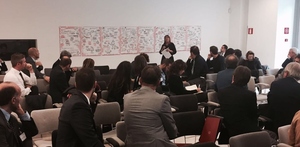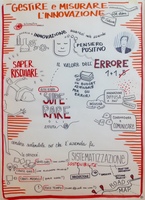"Se non accetti l'errore fai fallire l'innovazione"

Con questa considerazione di Roberto Vavassori, Consigliere di Kilometro Rosso e Direttore Business Development di Brembo, si è aperta la terza edizione di "Gestire e misurare l'innovazione 2017", l'evento dedicato all'innovazione organizzato da Strategie&Innovazione lo scorso 4 ottobre.
Nel nostro lavoro, così come nella vita personale, possiamo compiere errori, anche involontari e casuali: l’importante è saperli riconoscere, accettare e considerarli come leve per andare avanti e migliorare.
Come sostiene anche Zuckerberg, «Le persone di successo non solo imparano dai propri errori, ma impiegano la maggior parte del loro tempo a sbagliare»
Quando si parla d'innovazione, è ancora più importante che la cultura aziendale sia in grado di valorizzare lo stimolo alla sperimentazione e la possibilità di sbagliare, facendo diventare l'errore parte integrante del processo innovativo.
Nell'articolo che segue vi sono alcuni spunti ed esperienze pratiche per comprendere come sia importante credere nell'errore: ricordiamoci un po' più spesso che "sbagliando s'impara"!
(...) What is the relationship of failure to innovation and why do so few organizations have a culture where the ability to fail or experiment is a valued part of innovation? What are the organizational barriers to this?
Innovation often stems from a botched experiment and many a product such as Viagra and the Post-It note has been a result of a failed experiment. (...)
Failure itself doesn’t lead to innovation but it’s how you deal with failure that matters (...). "Rather than abandon a failed initiative, if you’re able to understand and learn from what went wrong then you’ll be able to improve your offer, product or service and try again and in turn make yourself more creative and thus innovative.”
The connotation associated with the word ‘failure’ is extremely negative both in society and in the workplace. (...) The essence of creativity and innovation is the ‘will to improve’
(...) a culture to experiment is far more likely to happen in start-ups than in large corporate cultures. “In the start-up community in Silicon Valley, they don’t call it failure. Instead they call it ‘pivoting’. Failure is such an energy sapping word with an awful lot of judgement whereas ‘pivoting’ means you’re still rapidly moving towards your goal but your shifting occasionally and learning before ‘pivoting’ back on track. We see it more in start-ups over corporate because we believe that some of them are a bit naive and don’t understand the challenges they are going to come up against. But this is a really positive thing as it means they’re not afraid to experiment, something which large organizations should do more.”(...)
Why do so few organizations have a culture where the ability to experiment and fail is a valued part of innovation? (...) The culture of experimentation in the workplace is unusual as only success is celebrated. “It’s a learned behavior pattern. As children we’re told that we need to succeed and are rewarded only when we do so. Managers in firms are only recognized and incentivized on their success and as a result are reluctant to take risks. Very few companies (...) actively incentivize managers if they admit early on that they’ve failed or reward the time spent on failed exploration projects.”
(...) a culture of creativity must first be developed in order to create a culture of innovation. “We know that creativity comes from intrinsic motivation of individuals and small groups. Innovation is an output of creativity. If you want to enhance innovation then you need to enhance team creativity. You need the right amount of time pressure and mixed teams to be creative. You need to mix teams in terms of profiles and also socio-economic backgrounds. Creativity refers to individual ways of thinking.”
One way of creating an innovative culture is by allowing employees to come up with great ideas and ways to improve their own jobs(...) You have to create an environment of trust where people have a passion to improve and they are excited about finding out how things work.”(...)
Tips for large corporates to foster a sense of innovation
• Organizations need to create an innovation ecosystem. Those organizations who are successfully and sustainably innovative have a living, breathing innovation ecosystem. And right at the core of this is a strong clear vision of what they are trying to achieve and how innovation fits within that.
• Organizations need a leadership team which can motivate, inspire and bring the organization along with them to deliver on that vision and the innovation part of it.
• The third part of that ecosystem is having people with the right skills and capability who are trained on how to have ideas and who know what their remit is and have the tools and resources to prototype, test and learn from their customers
• Underneath all of that is a structure and process which encourages, enforces and empowers innovation. All of those together create a culture of innovation.
Fonte: www.forbes.com
Per scambiare idee ed esperienze sulla cultura dell'innovazione scrivi a stratinnov@stratinnov.it
Leggi anche Il ruolo dell'Innovation Leader per promuovere l'innovazione



